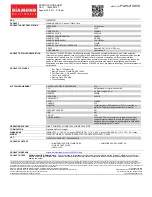
Kvaser PCI104 User's Guide
8(17)
Kvaser AB, Mölndal, Sweden — www.kvaser.com
3.3 Isolated CAN Drivers
Each CAN transceiver is isolated from the CAN controller and all other CAN transceivers. The
CAN driver will get the necessary power from the PCI bus via an isolated DC/DC convert. The
isolation between the CAN controller and the CAN transceiver has a delay of maximum 50 ns
in each direction. This will reduce the possible cable length with 20 meter compared to having
no isolation.
3.4 Stack-Through Connector
The PCI104 specification establishes a standard for the use of a high speed PCI bus in
embedded applications. The Kvaser PCI104 modules are self-stacking and do not require a
card cage or other interconnect support. In addition, the modules are also stackable with
standard PC/104-plus modules.
3.5 Inner and Outer Shield
There are two shield connections to this board: the inner and outer shield. The inner shield,
pin 9 at IDC, is the EMC filter shield ground. This shield ground must be kept /- 50
Volt from CAN GND. If the CAN GND has a voltage above +/- 30 Volt, CAN GND and inner
shield be shorted together. For EMC performance it is best if inner shield and CAN GND is
shorted together. The reason to keep them separated is to make it possible to have inner
shield connected to the metallic cover of the electronic device and still have CAN GND
floating, but limited to +/- 30 Volt from the shield.
The outer shield is the normal shield that should be connected to the shield of the CAN bus
cable. It is connected to IDC pin 10. The outer shield can have a v/- 540 Volt from
CAN GND and +/- 270 Volt from internal ground. If the voltage increase above those levels
will the current flow increase up to 200 ampere. There is no current limit, so high current
energies will burn away a component or the wire. ESD and high voltage noise will by this
function be discharged to ground and prevent users from getting sparks when touching the
isolated wires.
Inner shield is AC shorted to outer shield via a 10 nF capacitor. Also the outer shield is AC-
shorted to internal ground. This will reduce the slew rate in the change of the CAN GND level
relative to internal ground.
3.6 Protection against over voltage
The CAN bus interface do have a protection against over voltage at the CANH and CANL
signals. If the voltage will increase above 28 Volt will there be a current flow from CANH and
CANL to ground. An increased voltage level will cause the CANH and CANL to be shorted to
ground and the current flow can increase to 100 ampere or more. The current flow will after a
few milliseconds be reduced to 200 mA. The same is true if there is an over voltage between
CANH and CANL. This part will prevent the CAN bus driver interface to break down due to
ESD, sparks and shortcut to power supply. A continues over voltage at the interface will break
down the protection device. It is the energy that breaks down the device. 30 kV during 10
microseconds is less damaging than 32 Volt over few seconds.



































